The first post here was about a Southern-themed party, and I recently had another one, experimenting with recipes from two more southern cookbooks, the 1950 Junior League cookbook Charleston Receipts and Edna Lewis and Scott Peacock’s The Gift of Southern Cooking. I’ll post about all the rest of the things that went into the meal soon, but I want to devote a post of its own to the centerpiece of the meal, a country ham.
If you’ve read Pig Perfect or any of the other pig porn books out there, you’ve read rapturous odes to true old country ham… along, inevitably, with laments of how the real thing gets harder to find, and the best known name in the biz, Smithfield, is in fact no longer making true country ham at all. True country ham is like prosciutto or jamon iberico, an artisanal product in which ham ages in lots of salt until it’s dense, funky, almost offputtingly salty yet blessed with a profound complexity of flavors. It takes forever and so, the story goes, it’s nearly commercially extinct.
Well, yes and no. This being the internet age, even as it disappears from conventional markets, we may be entering a new golden age of country ham in which it’s no further away than the nearest FedEx truck. It’s not at all difficult to find suppliers online, and I had one in hand within three days of deciding that country ham was going to be the main course. I ordered mine from Father’s in Bremen, Kentucky:
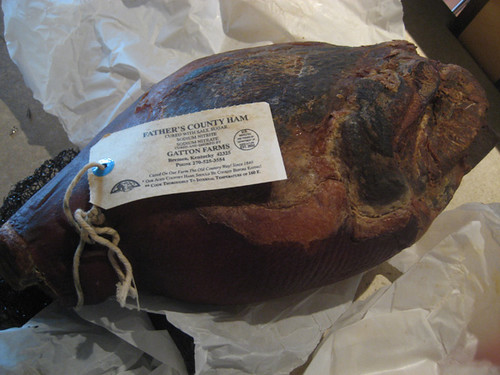
$38 plus shipping that brought it to about $50, still a relative bargain compared to others going for at least $60 or $70. Does one want a cheap country ham? Well, no, but I found this on some site being touted as the best value out of the ones sampled, so it sounded good to me.
It certainly smelled good— smoky, funky, hammy. Three days of soaking followed, and then I trimmed, laboriously, the rind off, revealing the naked, prosciutto-like ham underneath:
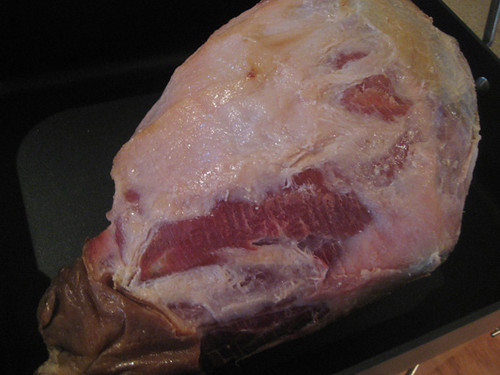
I had found an intriguing recipe in Charleston Receipts: it called for making a sort of gingerbread shell for the ham, full of cinnamon, cloves, and brown sugar, with a little pickling juice from whatever fruit you have handy thrown in. I rolled this thick dough out (another laborious process):
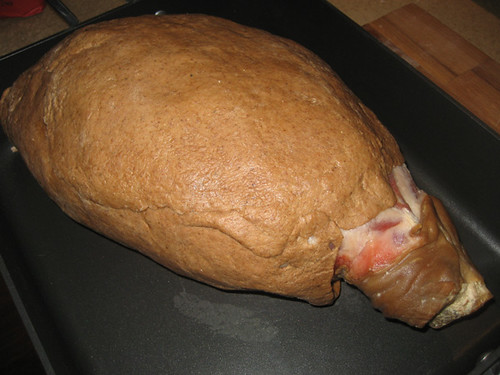
There’s something vaguely Flintstonian about the way that looks, like a drumstick of fried chickenosaurus. Five hours of baking, filling the house with Christmas cookie smells, and it looked like this:
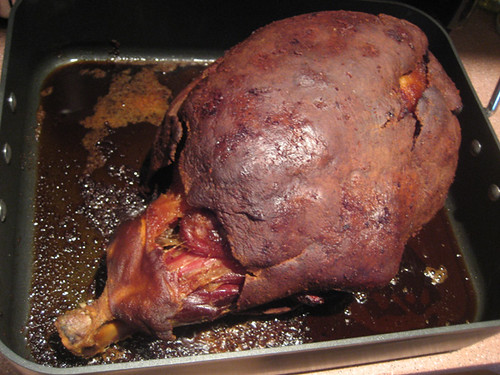
It went off to the side while I prepared other things. Finally the time came to serve it, so I cracked the shell and started carving into it:
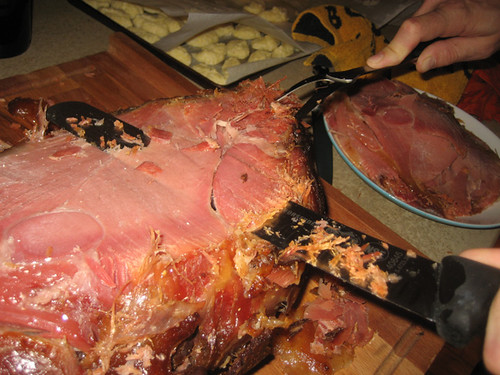
Actually, that’s Art, of my foraging video and The Pleasant House, carving as I raced to get the greens dished up and the biscuits baked:
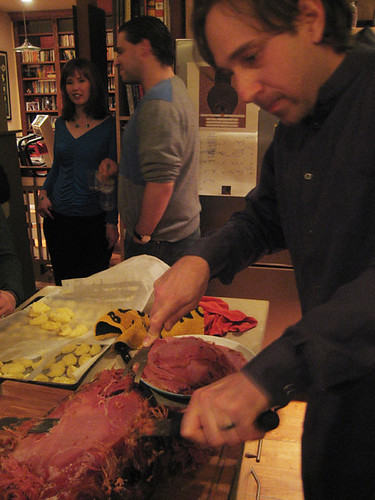
Charleston Receipts actually assumes you’ll glaze and finish it some other way, but that really wasn’t necessary except for appearance, if you wanted a perfect looking ham. As far as flavor went— it was great, the salty smoky meat being counterpointed by the sweetness that the crust imparted. Some parts were tough, prosciutto-funky, others tender and juicy, the ring of fat was like bacon on some pieces, it was a wonderful meat that revealed different sides of its flavor seemingly with every bite. I think the crust roasting method, as hard work as it was compared to simply baking it with a lot of gooey topping, really did a lot to preserve the ham’s own flavor and juices and impart spice notes that enhanced it.
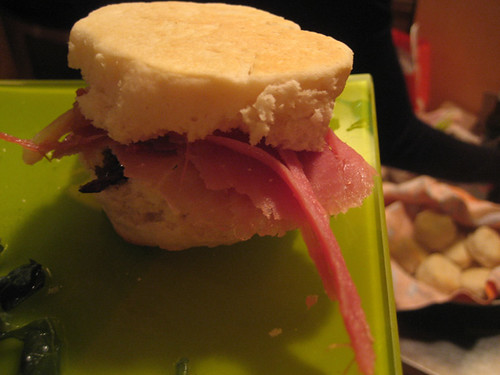
I made biscuits and had a variety of things to put on it— homemade fig preserves and apple chutney from The Gift of Southern Cooking, as well as Stonewall Kitchen’s Country Ketchup (which is really good, very tangy and more like a relish than ketchup) and other stuff. But pretty much anything you did with this ham, including cut some off the next morning and pop it straight in your mouth, was plenty good. I’m glad I added country ham to my repertoire. Even if it’s not something I’ll make often— as Lincoln said, “There is nothing more like eternity than a train ride of eleven days, unless it’s two people and a ham”— I can easily see making it once a year, setting aside some of the harder chunks for future use in soup, and picking it down to the bone over a couple of weeks each time.
Tags: country ham, edna lewis, scott peacock, southern, southern cooking, southern receipts

 Posted in
Posted in 




